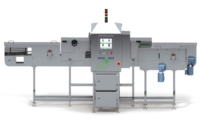Special Report: Flexible Film
New Film Development Can Flag Contaminated Foods

The Centers for Disease Control and Prevention (CDC) estimate that about 48 million Americans fall ill from foodborne illnesses each year. Of these 48 million people, more than 125,000 are hospitalized. An estimated 3,000 die domestically, and the World Health Organization says that about 420,000 people die globally from such illnesses every year.
While the hospitalization and mortality rate is a comparably small drop in the bucket when it comes to other illnesses and diseases, researchers have ID’ed more than 250 foodborne diseases that may pose a threat to the food we eat every day. Some of the more common germs that can pose a foodborne threat to people include norovirus and salmonella. Other, often more harmful, germs include listeria and E.coli.
Yes, there are the four simple food safety steps – clean, separate, cook, chill – to help minimize the risk of food poisoning, but minimizing risk doesn’t directly translate to eliminating it. But now, thanks to a development at McMaster University in Hamilton, Ontario, Canada, foodborne illnesses may be one step closer to more convenient detection.

Specifically, researchers have integrated postage stamp-sized pathogen detectors into flexible film that’s coated with molecules throughout. These detectors and molecules thereby cause the film to glow when it detects contamination. In testing, the film glowed when it both came into contact with E.coli cells and when it was in the presence of E.coli cells. The development could prove to be a viable solution for lidding films or wraps, particularly those that package meats and produce – and it’s a development that could greatly reduce the number of illnesses, hospitalizations and deaths from foodborne illnesses each year. At the time of this writing, an E.coli outbreak linked to romaine lettuce was responsible for more than 120 illnesses and one death.
The McMaster University research was detailed in an April 2018 report in ACS Nano.
Presently, the film must be viewed under an ultraviolet lamp or with a fluorescent scanner to see if it’s glowing, but this could easily be made more convenient for consumers via a smartphone app or if a grocer were to install the appropriate equipment for shoppers to check for themselves while in store.
The next step for researchers is testing the development with other bacteria.
McMaster University
Looking for a reprint of this article?
From high-res PDFs to custom plaques, order your copy today!





